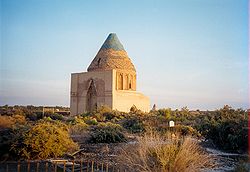- Konye-Urgench
-
Kunya-Urgench * UNESCO World Heritage Site Soltan Tekeş Mausoleum
Soltan Tekeş MausoleumCountry Turkmenistan Type Cultural Criteria ii, iii Reference 1199 Region ** Asia-Pacific Inscription history Inscription 2005 (29th Session) * Name as inscribed on World Heritage List
** Region as classified by UNESCOKonye-Urgench (Turkmen: Köneürgenç, Russian: Куня Ургенч, from Persian Kuhna Gurgānj کهنه گرگانج) also known as Konya-Urgench, Old Urgench or Urganj, is a municipality of about 30,000 inhabitants in north-eastern Turkmenistan, just south from its border with Uzbekistan. It is the site of the ancient town of Ürgenç (Urgench), which contains the unexcavated ruins of the 12th-century capital of Khwarezm. Since 2005, the ruins of Old Urgench have been protected by UNESCO as a World Heritage Site.[1] (See List of World Heritage Sites in Turkmenistan)
Formerly situated on the Amu-Darya River, Old Ürgenç was one of the greatest cities on the Silk Road. Its foundation date is uncertain, but the extant ruins of the Kyrkmolla fortress have been dated (rather ambitiously) to the Achaemenid period[1]. The 12th and early 13th centuries were the golden age of Ürgenç, it became the capital of Khorezm Empire and it surpassed in population and fame all other Central Asian cities barring Bukhara[1]. In 1221, Genghis Khan razed it to the ground in one of the bloodiest massacres in human history.
The city was revived after Genghis's assault, but the sudden change of Amu-Darya's course to the north and the town's destruction again in the 1370s, this time by Timur, forced the inhabitants to leave the site forever.[1]
The area was later inhabited by Turkmen in 1831, but they built outside the old town, using it as a graveyard.[1]
A new town of Urgench was developed to the Southeast, in present-day Uzbekistan. First archeological research on the old city site was conducted by Alexander Yakubovsky in 1929.
Most of Ürgenç's monuments have completely or partly collapsed. Nowadays, the site contains three small mausoleums of the 12th century and the more elaborate 14th-century Törebeg Hanym Mausoleum, which was much restored in the 1990s.
The most striking extant landmark of Old Urgench is the early 11th-century Gutluk-Temir Minaret, which, at 60 meters, used to be the tallest brick minaret prior to the construction of the Minaret of Jam - which was later surpassed by the Qutb Minar when it was completed in 1368. Also of note is the Il-Arslan Mausoleum - the oldest standing monument: a conical dome of 12 facets, housing the tomb of Mohammed II's grandfather, Il-Arslan, who died in 1172. Somewhat to the north, sprawls a vast medieval necropolis.
References
- ^ a b c d e "Kunya-Urgench". UNESCO World Heritage Center. UNESCO. http://whc.unesco.org/en/list/1199. Retrieved 19 February 2011.
External links
 Media related to Kunya Urgench at Wikimedia Commons
Media related to Kunya Urgench at Wikimedia CommonsCoordinates: 42°20′N 59°09′E / 42.333°N 59.15°E
Ahal Province Abadan City • Akbugdaý District • Babadaýhan District • Baharly District • Gökdepe District • Kaka District • Ruhabat District • Sarahs District • Tejen DistrictBalkan Province Bereket District • Esenguly District • Etrek District • Magtymguly District • Serdar District • Türkmenbaşy DistrictDaşoguz Province Daşoguz City • Köneürgenç City • Akdepe District • Boldumsaz District • Görogly District • Gubadag District • Gurbansoltan Eje District • Köneürgenç District • Saparmyrat Nyýazow District • Saparmyrat Türkmenbaşy DistrictLebap Province CountyAtamyrat District • Beýik Türkmenbaşy District • Birata District • Farap District • Galkynyş District • Garabekewül District • Garaşsyzlyk District • Halaç District • Hojambaz District • Köýtendag District • Magdanly District • Sakar District • Saýat District • Serdarabat District • Seýdi DistrictCityMagdanly • Seýdi • TürkmenabatMary Province Baýramaly City • Baýramaly District • Ýolöten District • Garagum District • Mary District • Murgap District • Oguzhan District • Sakarçäge District • Serhetabat District • Tagtabazar District • Türkmengala District • Wekilbazar District Cities of Turkmenistan
Cities of TurkmenistanCapital Other cities Abadan • Akdepe • Baharly • Balkanabat • Baýramaly • Darganata • Daşoguz • Esenguly • Gyzyletrek • Kerki • Kunya Urgench • Mary • Serdar • Tagtabazar • Tejen • Turkmenabat • Turkmenbashi • ÝolötenCategories:- Archaeological sites in Turkmenistan
- Ruins in Turkmenistan
- 11th-century architecture
- Populated places along the Silk Road
- World Heritage Sites in Turkmenistan
- Populated places in Turkmenistan
- Districts of Turkmenistan
Wikimedia Foundation. 2010.


